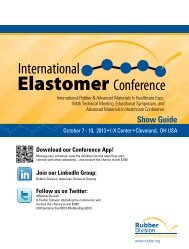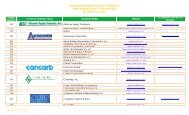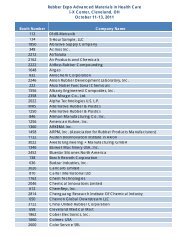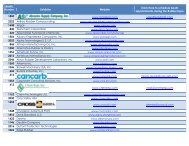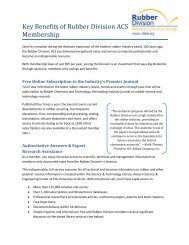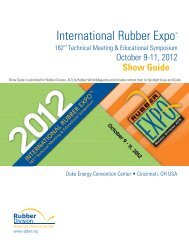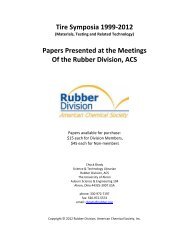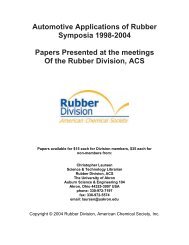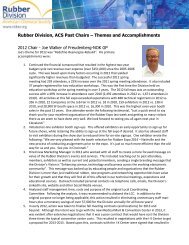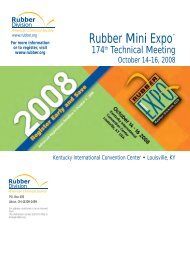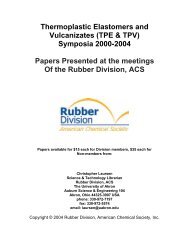Training Directory - Rubber Division
Training Directory - Rubber Division
Training Directory - Rubber Division
Create successful ePaper yourself
Turn your PDF publications into a flip-book with our unique Google optimized e-Paper software.
PRODUCTS & APPLICATIONS<br />
Introduction to Dispersions<br />
4 hours<br />
CEUs: .4<br />
This course will start with a detailed explanation on how dispersion<br />
is accomplished in rubber, including both liquids and solids.<br />
Next, each type of dispersion will be studied, including the<br />
common carriers and their capabilities. When discussing the<br />
polymer bound dispersion, several polymer types and combination<br />
will be examined. Finally, each type of dispersion will be explored<br />
as to their benefi ts and limitations.<br />
Chemical Structures and<br />
Viscoelasticity of <strong>Rubber</strong><br />
4 hours<br />
CEUs: .4<br />
This course is designed to focus on the chemistry of rubber and<br />
the other compound ingredients and their effects on viscoelasticity<br />
rather than the mathematical models and laboratory methods<br />
of measuring rubber viscoelasticity. The viscoelastic models,<br />
theories and defi nitions are covered, but the main focus is on<br />
the rubber compounding side. The viscoelastic properties of<br />
non-tire mechanical goods and tires are discussed, versus their<br />
performance properties.<br />
Course Outline:<br />
1. Viscoelastic Theory – Elastic and Viscous Behavior<br />
a. Hooke’s Law<br />
b. Newton Dashpot Model<br />
c. Brownian Motion<br />
d. Maxwell Model<br />
e. Kelvin-Voigt Model<br />
2. Elastomer Phases with Temperature Change<br />
a. Glassy Region<br />
b. Glass Transition Region (Tg)<br />
c. <strong>Rubber</strong> Region<br />
d. Flow Region<br />
e. Time-Temperature Superposition Theory<br />
3. Viscoelastic Properties Defi nitions<br />
a. Elastic Modulus<br />
b. Viscous Modulus<br />
c. Tan Delta<br />
d. Complex Modulus<br />
e. Loss Compliance<br />
4. Laboratory Measurement of Viscoelastic Properties<br />
5. Laboratory Viscoelastic Properties for Non-tire <strong>Rubber</strong><br />
Applications<br />
6. Laboratory Viscoelastic Properties for Tire Applications<br />
7. Elastomer Chemical Structure and Viscoelastic Properties<br />
a. Elastomer Backbone Flexibility<br />
b. Bulkiness of the Side Groups<br />
c. Steric Hindrance<br />
d. Flexibility of Side Groups<br />
e. Symmetry of Side Groups<br />
f. Homogeneous Versus Heterogeneous Elastomers<br />
g. Molecular Weight<br />
h. Elastomer Branching<br />
i. Polymer Chemical Modification<br />
8. Common <strong>Rubber</strong> Chemical Structures and Glass Transition<br />
Temperatures<br />
a. SBR, styrene butadiene rubber<br />
b. BR, butadiene rubber<br />
c. EPDM, ethylene propylene diene rubber<br />
d. IIR, CIIR, CIIR, butyl, bromobutyl and chlorobutyl rubbers<br />
e. NBR, HNBR, XNBR, butadiene acrylonitrile rubbers<br />
f. CR, polychloroprene rubber<br />
g. CSM, chlorosulfonated polyethylene rubber<br />
h. ECO, epichlorohydrin rubber<br />
i. ACM, polyacrylic rubber<br />
j. MQ, VMQ, PMQ, PVMQ, FVMQ, silicone rubbers<br />
k. AEM, ethylene acrylic rubber<br />
l. FKM, fluorocarbon rubber<br />
9. Non-rubber <strong>Rubber</strong> Compound Ingredients and Viscoelastic<br />
Properties<br />
a. Carbon Black<br />
b. Mineral Fillers<br />
c. Plasticizers, Oils and Process Aids<br />
10. Vulcanization System and Viscoelastic Properties<br />
Key To Symbols<br />
Online Registration<br />
Certifi cate/CEUs Awarded<br />
On-site<br />
E-learning<br />
International<br />
14 RUBBER DIVISON, ACS EDUCATION OPPORTUNITIES



